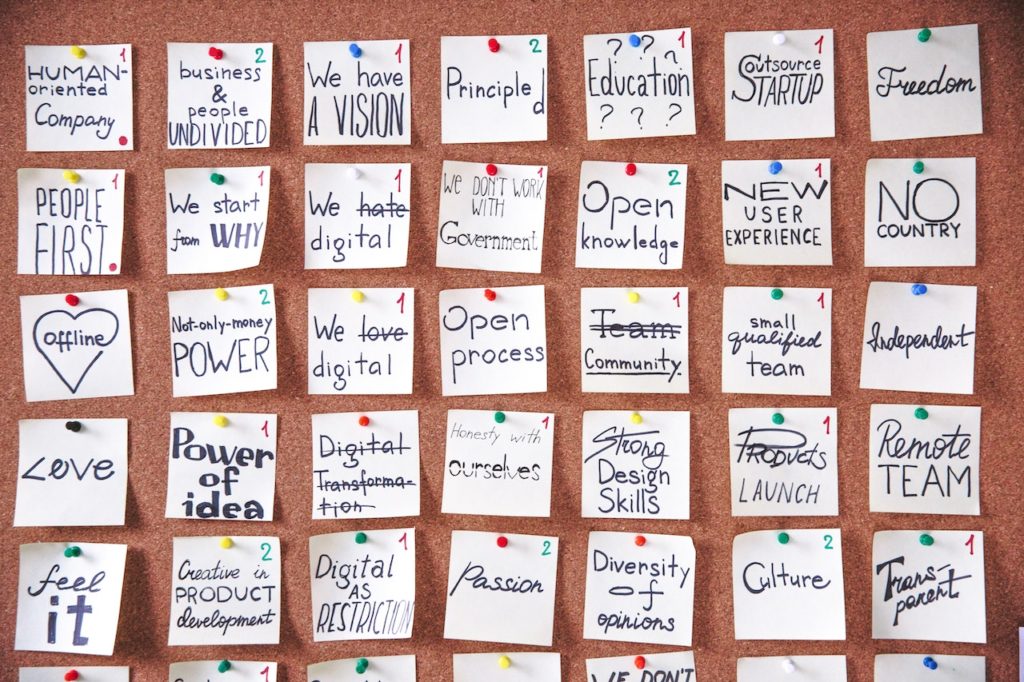Simple Step-by-Step Method to Set Empowering Goals
Introduction
Life is a journey, and on this journey, goals serve as our compass. They guide us toward our desired destination and give our lives a sense of direction.
This article provides a simple step-by-step method to help you set goals that will transform your life.
Remember, it’s not just about setting goals; it’s about setting empowering goals.
1. Identify Your True Desires
The first step in setting empowering goals involves identifying your true desires. What drives you? What are your passions, and what would you like to achieve in life?
Reflect on these questions and take some time to understand what truly matters to you.
Setting goals that are aligned with your desires and values will not only give you a sense of purpose but also keep you motivated in the pursuit of your goals.
Here are 3 recognized methods that can assist you in this introspective process:
Self-Reflection and Journaling (Introspective Method)
Self-reflection is a powerful tool for identifying your true desires. Many psychologists and life coaches, like Julia Kristina and Jordan B. Peterson, recommend this method. Start by asking yourself questions about your passions, dreams, and values. Write these questions and your responses down in a journal.
It could include queries like “What activities make me lose track of time?” or “What would I do if I knew I could not fail?”. This method helps in gaining clarity about what you truly desire in life.

The Ikigai Concept (Japanese Method)
The Japanese concept of Ikigai, popularized by authors such as Hector Garcia and Francesc Miralles, can be a valuable tool in identifying your true desires. Ikigai, often translated as “a reason for being,” is the intersection of four fundamental components: what you love, what you are good at, what the world needs, and what you can be paid for.
By reflecting on these components, you can gain insights into your true desires that lie at the confluence of your passion, mission, vocation, and profession.
Vision Boards (Creative Visualization Method)
Endorsed by self-help gurus like Jack Canfield and Rhonda Byrne, vision boards are another effective tool for identifying your true desires. A vision board is a collage of images and words representing your dreams and goals.
By selecting images and words that resonate with you, you are essentially visualizing and articulating your desires. The process of creating a vision board can be enlightening, revealing desires you may not have initially recognized.
By employing these methods, you can gain a deeper understanding of yourself and your true desires, paving the way for setting empowering goals aligned with your core values and aspirations.
Remember, identifying your true desires is the foundational step in goal-setting, and spending ample time on this process can make a significant difference in your journey toward achieving empowering goals.
2. Visualize Your Goals
Once you’ve identified what you want, the next step is to visualize it. Visualization is a powerful tool that can help you set empowering goals. Picture yourself achieving your goals and imagine the feelings associated with that achievement.
This exercise will not only make your goals more tangible but also create a sense of excitement and anticipation, thus empowering you to take action.
Let’s discuss two examples that employ different strategies: creating a vision board and practicing guided visualization.

Example 1: Creating a Vision Board
Let’s say you’re a budding entrepreneur whose goal is to launch a successful eco-friendly clothing brand. To visualize this, you decide to create a vision board.
On this board, you paste pictures representing various aspects of your goal: sketches of clothing designs, images of materials you’d like to use, and photos of successful eco-friendly brands for inspiration. You also include some motivational quotes about sustainability and entrepreneurship and maybe a chart representing your desired sales growth.
Each time you look at your board, you’re reminded of your goal and can imagine your brand taking shape. The vision board is a powerful visual cue, aligning your thoughts and actions toward achieving your dream.
Example 2: Guided Visualization
Another way to visualize your goals involves a more introspective process. Suppose your goal is to become a public speaker who inspires young minds. To visualize this, you can practice a form of guided visualization.
Close your eyes and take some deep, calming breaths. Then, picture yourself standing on a stage in front of an auditorium full of eager listeners. Imagine the warmth of the spotlight on your face, the sound of your voice echoing through the room, and the attentive faces of your audience. Feel the satisfaction and joy of delivering a talk that captivates and inspires.
This detailed visualization creates a powerful mental image that can motivate and guide you toward achieving your goal. By repeatedly practicing this visualization, you’re conditioning your mind to believe in your capability and to take action towards becoming an inspiring public speaker.
Both of these methods tap into the power of your imagination, painting vivid images of your goals that can inspire and motivate you to make them a reality. Visualizing your goals is a way of affirming your intentions and setting your sights on the outcomes you desire. Remember, seeing is believing, and visualizing your goals can be the first step toward achieving them.

3. Set Specific Goals
Specificity is crucial when it comes to setting goals. A vague goal like “I want to be successful” can be confusing and uninspiring. Instead, try to define what success looks like for you.
Do you want to own a successful business, become a renowned author, or run a marathon? Set specific goals that clearly outline what you aim to achieve.
It’s also essential to craft SMART goals, that are Specific, Measurable, Achievable, Relevant, and Time-bound. Let’s dive into some examples.
Example 1: Solo Entrepreneur
Goal: Increase Customer Base
As a solo entrepreneur running an online retail store, one of your goals might be to increase your customer base. Here’s a SMART goal:
“I want to increase my customer base by 20% over the next 6 months by implementing a comprehensive social media marketing strategy that targets my ideal customer profile, posts engaging content three times a week, and utilizes sponsored ads to reach a wider audience.”
This goal is specific, measurable with analytics tools, achievable with concerted effort, relevant to business growth, and has a time-bound target.
Example 2: Solo Entrepreneur Skincare Business
Goal: Launch New Product Line
As a solo entrepreneur with a skincare business, you might be interested in launching a new product line. Here’s a SMART goal:
“I aim to research, develop, and launch a new line of vegan skincare products in the next 9 months. I will dedicate 15 hours per week for research and development, partner with ethical suppliers, and plan a pre-launch marketing campaign to create buzz and secure pre-orders.”
Again, this goal is specific (launching a vegan skincare line), measurable (by the successful launch and pre-orders), achievable (with time dedication and partnerships), relevant (extends the existing product portfolio), and time-bound (9 months).
Example 3: Self-help / Personal Health
Goal: Improve Physical Fitness
If your focus is on personal health, a potential goal might be improving your physical fitness. Here’s a SMART goal:
“To improve my cardiovascular health and lose 15 pounds, I will commit to a combination of a balanced diet and regular exercise for the next 4 months. I will engage in at least 30 minutes of aerobic exercise five days a week, cut down on processed foods, and keep a weekly journal to track my progress.”
This goal is specific (improving cardiovascular health and losing weight), measurable (through weight loss and fitness tracking), achievable (with diet and exercise), relevant (to personal health), and time-bound (4 months).
Remember, setting SMART goals not only provides you with clear direction but also helps you stay motivated and increases your chances of achieving your desired results.
Check out this article How to Take the First Step to Change Your Life to get started

4. Make Your Goals Measurable
After setting specific goals, make sure they are measurable. This will allow you to track your progress and stay motivated.
Making your goals measurable involves defining tangible evidence that the goal has been accomplished. It could be a number, a milestone, or a tangible product. This creates clarity and allows you to track your progress. Let’s delve deeper into it with three examples.
Example 1: Improve Personal Savings
Let’s assume you want to boost your personal savings. A SMART goal for this could be:
“I will save $5000 by the end of this year. To achieve this, I will set aside $420 every month. I will track my progress using a budgeting app and adjust my monthly budget if needed.”
In this case, the measurable aspect of your goal is the amount of money saved ($5000), and the tracking method is the budgeting app.
Example 2: Increase Productivity at Work
If you’re looking to be more productive at work, a measurable goal might look like this:
“I aim to reduce the time I spend on non-essential tasks by 20% over the next three months. I will use a time tracking app to identify where my time is currently spent, and then implement strategies such as task batching, time blocking, and using a productivity planner to manage my time more effectively.”
Here, the measurable part is the reduction in time spent on non-essential tasks (20%), and the tool to measure this is a time-tracking app.
Example 3: Increase Social Media Presence for a Business
For a solo entrepreneur who wants to increase their social media presence, a measurable goal could be:
“I want to increase my Instagram followers by 2000 and engagement rate by 5% over the next six months. I will post daily, use relevant hashtags, engage with followers, and analyze weekly metrics using Instagram’s Insights feature to track my progress.”
In this case, the measurable aspects are the number of new followers (2000) and the increased engagement rate (5%), and the tool for measuring progress is Instagram’s Insights.
By making your goals measurable, you create a clear path toward achieving them and have a concrete way of knowing when you’ve reached your desired result.

5. Set Realistic but Challenging Goals
Setting realistic but challenging goals means creating objectives that stretch your abilities but are still within reach. This balance is essential because while it’s important to strive for greatness, setting goals that are too far out of your comfort zone can result in frustration and ultimately failure. Here’s how you can set realistic yet challenging goals.
1. Consider Your Resources
Resources include time, money, skills, and assistance from others. For instance, if you’re working full-time and planning to start a side business, a goal to launch within a month may be unrealistic due to your limited time.
Instead, a more realistic but still challenging goal could be to launch within six months.
2. Assess Your Abilities
Understanding your strengths and weaknesses is crucial in setting realistic goals. If you’re a solo entrepreneur aiming to expand your business, a realistic goal could involve tasks that require skills you already have or can easily acquire.
For instance, if you’re great at sales but lack knowledge in digital marketing, your goal could be to double your sales over the next year, while taking a digital marketing course to expand your skills.
3. Set Incremental Goals
Large goals can seem daunting and unattainable. To make them more manageable and realistic, break them down into smaller, incremental goals. For example, if your overall objective is to run a marathon, start with a goal of running a 5k, then a 10k, and so on.
4. Embrace Challenges
While your goals should be realistic, they also need to push you beyond your comfort zone to promote personal and professional growth. For example, if you’re an artist who usually creates five paintings a month, challenge yourself to create seven. This stretches your abilities without setting an unachievable target.
5. Review and Adjust
Finally, continually review your goals and adjust them as needed. If a goal proves too easy, make it more challenging. If it’s too hard, scale it back. Flexibility is key to maintaining momentum and achieving success.
By setting realistic yet challenging goals, you create an optimal pathway towards success that encourages growth without leading to unnecessary stress or disappointment. It’s about understanding your abilities and pushing your boundaries in a healthy, achievable way.

6. Create a Plan of Action
Now that you have your empowering goals in place, it’s time to create a plan of action. Break down your goals into manageable tasks and outline the steps needed to achieve them. This will not only make your goals seem more achievable but also provide you with a clear roadmap toward success.
Absolutely! Creating a plan of action is like drawing a roadmap to your goals. It outlines the steps you need to take to achieve your objectives and helps you focus on what’s important. Here’s a step-by-step process to create an effective plan of action.
Break Down Your Goals
Start by breaking your goals into smaller, manageable tasks. Each task should represent a step toward your ultimate goal. This makes your overall objective seem less daunting and more achievable. For example, if your goal is to start a blog, some tasks might include “Decide on a blog topic,” “Create a content plan,” “Design the blog,” and “Promote the blog.”
Set Priorities
Not all tasks are of equal importance. Identify which tasks are most critical to your goal and focus on them first. Using the blog example, deciding on a topic and creating a content plan might take priority over designing the blog.
Assign Deadlines
Deadlines are crucial as they keep you accountable and on track. Assign a deadline for each task based on its priority and the time you estimate it’ll take to complete. Be realistic, but also challenge yourself to maintain momentum.
Identify Potential Obstacles
Consider the challenges you might face in achieving your goals and plan for them in advance. For example, you might encounter technical issues when designing your blog. Having a plan to deal with such obstacles (like enlisting the help of a tech-savvy friend or hiring a professional) ensures they don’t derail your progress.
Monitor Your Progress
Regularly review your plan of action to see how you’re progressing. Celebrate your victories, no matter how small, and adjust your plan as needed. If a task is taking longer than expected, reassess your deadline or approach.
Stay Flexible
Remember, your plan of action is a guide, not a rigid set of rules. Life is unpredictable, and you may need to modify your plan as circumstances change. Stay flexible and willing to adapt. Adjust your plan if a particular task becomes irrelevant or another priority arises.
Creating a detailed plan of action not only gives you a clear path to follow but also increases your confidence and motivation to achieve your goals. It takes the guesswork out of “what should I do next?” and allows you to focus on taking action.

7. Regularly Review and Adjust Your Goals
The final step in setting empowering goals is to regularly review and adjust them. Your goals are not set in stone. They’re meant to guide you, but it’s essential to keep them relevant and in line with your current situation and desires.
Here’s how to approach the review and adjustment process.
Schedule Regular Reviews
Goal setting isn’t a one-time event. It’s a continuous process that requires you to stay engaged and committed. Schedule regular reviews—monthly, quarterly, or even weekly—to assess your progress. Consider it a meeting with yourself about your future.
Measure Your Progress
During these reviews, measure your progress toward your goals. Are you moving forward? If not, why not? Be honest with yourself during this assessment. Are the actions you’re taking bringing you closer to your goals, or do they need adjusting?
Celebrate Your Successes
Recognize and celebrate your successes, no matter how small. Celebrations not only make the journey enjoyable but also boost your motivation. They reinforce the positive behavior that led you to achieve those milestones.
Identify Challenges and Solutions
If you’re not making as much progress as you’d hoped, identify the challenges you’re facing. Are there obstacles that you didn’t anticipate? Once you’ve identified the problem, brainstorm potential solutions. You might need to learn a new skill, seek help, or allocate more time to the task at hand.
Adjust Your Goals
Life changes, and so can your goals. Maybe you’ve achieved your goal sooner than expected, or perhaps it no longer aligns with what you want. It’s okay to adjust your goals, make them more challenging, or change them altogether.
Your goals should serve you—not the other way around.
Keep Your Vision in Mind
Never lose sight of your ‘why’—the vision that inspired your goals in the first place. This vision can keep you motivated during challenging times and remind you of what you’re working towards.
In conclusion, regular review and adjustment of your goals is critical for your success. It allows you to stay flexible, overcome challenges, and keep your goals aligned with your aspirations. Remember, the journey toward achieving your goals is just as important as the destination.
Conclusion
Setting empowering goals is a dynamic process that requires self-awareness, visualization, specificity, measurability, realism, a solid plan, and regular review.
By following these seven simple steps, you can set empowering goals that will fuel your personal and professional growth.
So, start today and set goals that will propel you toward your desired future. After all, the key to a fulfilling life lies in setting and pursuing empowering goals.
Get started with our 21 days challenge.








4 Comments
Comments are closed.